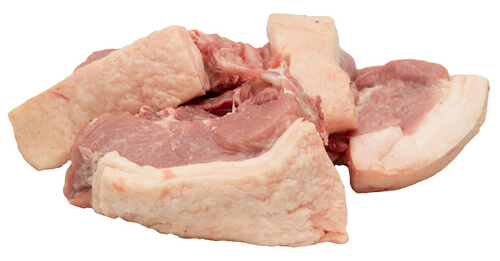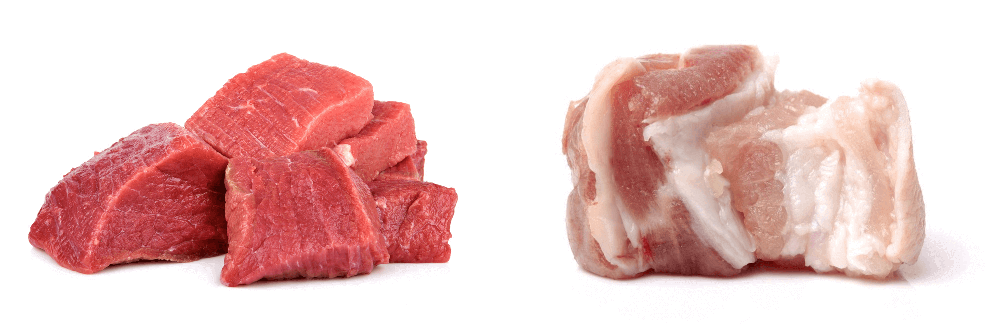Fat-to-Protein Ratio Helps Detect Inferior Meat Content in Dog Food
DogFoodAdvisor is reader supported See how
Dog Food Advisor is 100% impartial and is never paid to promote any brand. But if you buy using links on this page, we may earn a referral fee.

Which Was Used to Make Your Dog’s Food?
It’s hard to believe.
Yet on a pet food label…
Each of the ingredients above can LEGALLY be called “meat”.
One is cut from fresh, lean beef… while the other consists of fatty trimmings sourced from slaughterhouse waste.
So…
How can you tell which one was used to make YOUR dog’s food?
The fat-to-protein ratio may help reveal the answer.
What’s Fat-to-Protein Ratio?
The fat-to-protein ratio is a number calculated from info found on every food label. It’s used by The Dog Food Advisor to help detect excessive levels of fatty meat hidden in a pet food.
Best of all…
You can calculate ‘FPR’ yourself.
Don’t worry. It’s easy. I’ll show you HOW in the next section.
How to Calculate ‘FPR’ Yourself
Look for the “crude fat” and “crude protein” numbers found in the “Guaranteed Analysis” section of every pet food label.
Then, grab a simple handheld calculator and:
- Divide the amount of fat… by the amount of protein
- And multiply that number by 100
And voila!
You’ve got the fat-to-protein ratio… expressed as a percentage.
Already Calculated for You
If you’d rather not calculate FPR yourself…
You can find it already done for you in every review we post on this website.
Simply find your dog’s food on our Reviews by Brand page. And in the “Nutrient Analysis” section…
You’ll find the fat-to-protein ratio, like this:

What Does FPR Tell You?
In general…
The higher the FPR… the more likely the food contains an excessive amount of fatty ingredients when compared to the amount of protein in that same recipe.
But…
Don’t take FPR literally. It’s an indicator of relative value only. Not an exacting measurement.
It’s like using your hand to test the temperature of the water in your bathtub. It tells you ONLY if it’s too hot. It doesn’t reveal the actual temperature.

So…
Don’t use FPR to micro-analyze or compare dog foods. That’s NOT its purpose.
You’re looking for outliers… recipes with CRAZY high FPR numbers. Numbers that are outside the range of ‘normal’. And suggest the likelihood the food was made with excessive amounts of fatty waste.
What’s a ‘Normal’ FPR?
The FPR can range anywhere from 30%… to over 100%.
As a rule…
The average FPR for both wet and dry foods appears to be about 55-60%.
Keep in mind…
The majority of dog foods will have FPRs below 90%… with most dry products hovering around 70%… or lower.
Wet dog foods are typically the most frequent offenders. It’s not unusual for some to have FPRs at the upper end of the range.
We tend to be suspicious of any dog food with an FPR that’s north of 80%.
And we down-rate recipes with FPRs that are 90% or higher.
Which is why…
You won’t find ANY recipes with extreme FPR numbers on our Best Dog Food pages.
What’s the FPR for Your Favorite Brand?
Visit The Advisor’s Reviews by Brand page… and check out the FPR for your dog’s current food.
Mike Sagman, Editor
The Dog Food Advisor
Saving Good Dogs From Bad Dog Food
Our Editor’s Top Picks
November
The following pages contain top-rated brands with favorable fat-to-protein ratios for the current month.
Final word
The Dog Food Advisor does not accept money, gifts, samples or other incentives in exchange for special consideration in preparing our reviews.
However, we do receive a referral fee from online retailers (like Chewy or Amazon) and from sellers of perishable pet food when readers click over to their websites from ours. This helps cover the cost of operation of our free blog. Thanks for your support.
For more information, please visit our Disclaimer and Disclosure page.




